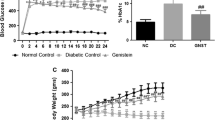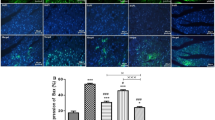Abstract
Earlier studies from one of the investigator’s laboratory have demonstrated the presence of a high molecular weight protein (182 kDa) in the blood serum of laboratory animals subjected to pressure-induced cardiac hypertrophy and suggested that this protein may be involved in the development of cardiac hypertrophy. Studies have shown that this protein is also involved in earlier stages of cardiac complications associated with diabetes, but the role of this protein in diabetic heart is less understood. So we aimed to check whether this protein is having any protective role in diabetic heart. The protein was purified from serum of rats induced with cardiac hypertrophy and the purified protein was injected through tail vein of diabetic rats for further studies. The results of various antioxidant enzymes and the TBARS levels have indicated the antioxidant activity of this protein. Real-time PCR analysis of gene expression revealed the upregulation of certain muscle-specific genes like β-MHC, MLC-2, and skeletal α actin in diabetic group and also in presence of 182-kDa protein. The results further showed a down regulation of genes such as cardiac α-actin and α- MHC implicating the role of this protein in the development of cardiac hypertrophy in diabetes. Increased cardiac hypertrophy as revealed by the expression of various genes and improved antioxidant potential in presence of 182 kDa protein in diabetes at the earlier stages is beneficial for counteracting the myocardial damage associated with diabetes.




Similar content being viewed by others
References
Garg MC, Ojha S, Bansal DD (1996) Antioxidant status of streptozotocin diabetic rats. Indian J Exp Biol 34:264–266
Boueiz A, Damarla M, Hassoun P (2008) Xanthine oxidoreductase in respiratory and cardiovascular disorders. Am J Physiol 294:L830–L840
Adeghate E (2004) Molecular and cellular basis of the aetiology and management of diabetic cardiomyopathy: a short review. E Mol Cell Biochem 261(1–2):187–191
Mariappan M, Selvamurugan N, Rajamanickam C (1994) Purification and characterization of a high molecular weight protein induced in rat serum during the development of cardiac hypertrophy. Arch Biochem Biophys 281(2):287–297
Rajamanickam C, Sakthivel S, Babu GJ, Lottspeich F, Kadenbach B (2001) Cardiac isoform of alpha-2 macroglobin, a novel serum protein, may induce cardiac hypertrophy in rats. Basic Res Cardiol 96:23–33
Rajan S, Radhakrishnan J, Rajamanickam C (2003) Direct injection and expression in vivo of full- length cDNA of the cardiac isoform of alpha-2 macroglobulin induces cardiac hypertrophy in the rat heart. Basic Res Cardiol 98:39–49
Annapoorani P, Dhandapany PS, Sadayappan S, Ramasamy S, Rathinavel A, Selvam GS (2006) Cardiac isoform of alpha-2 macroglobulin—a new biomarker for myocardial infarcted diabetic patients. Atherosclerosis 186:173–176
Prabhakar R, Rajamanickam C (1993) Serum protein of 135 kDa molecular weight—a molecular signal for cardiac hypertrophy. Arch Biochem Biophys 302:425–430
Ohkawa H, Ohishi N, Yagi K (1959) Assay for lipid peroxides in animal tissues by thiobarbituric acid reaction. Anal Biochem 95:351–358
Kakkar P, Das B, Viswanathan PN (1984) A modified spectrophotometric assay of superoxide dismutase. Indian J Biochem Biophys 2:130–132
Maehly AC, Chance B (1954) The assay of catalases and peroxidases. Methods Biochem Anal 1:357–424
Lawrence RA, Burk RF (1976) Glutathione peroxidase activity in selenium-deficient rat liver. Biochem Biophys Res Commun 4:952–958
David M, Richard JS (1983) Glutathione reductase. In: Bergmeyer HU Jr (ed) Methods of enzymatic analysis, vol 3. Academic Press, New York, p 258
Bergmeyer HU, Gawehn K, Grassl M (1974) Methods of enzymatic analysis, 2nd edn. Academic Press, New York, pp 521–522
Ellen SL, Reginald HG (1978) Regulation, Purification, and properties of xanthine dehydrogenase in Neurospora crassa. J Biol Chem 253:2604–2614
Cai L, Kang YJ (2001) Oxidative stress and cardiomyopathy: a brief review. Cardiovasc Toxicol 1:181–193
Cai L, Li W, Wang G, Guo L, Jiang Y, Kang YJ (2002) Hyperglycemia- induced apoptosis in mouse myocardium: mitochondrial cytochrome C-mediated caspase-3 activation pathway. Diabetes 51:1938–1948
Depre C, Young ME, Ying J, Singh Ahuja H, Han Q, Garza N, Davies PJA, Taegtmeyer H (2000) Streptozotocin-induced changes in cardiac gene expression in the absence of severe contractile dysfunction. J Mol Cell Cardiol 32:985–996
Berry CE, Hare JM (2004) Xanthine oxidoreductase and cardiovascular disease: molecular mechanisms and pathophysiological implications. J Physiol 555:589–606
Wang J, Han Y, Su H, Mu L (2004) Expression of unique and developmental myosin heavy chain isoforms in adult human digastric muscle. J Histochem Cytochem 52:851–859
Reiser PJ, Portman MA, Ning X-H, Moravec CS (2001) Human cardiac myosin heavy chain isoforms in fetal and failing adult atria and ventricles. Am J Physiol Heart Circ Physiol 280:H1814–H1820
Corbett JM, Why HJ, Wheeler CH, Richardson PJ, Archard LC, Yacoub MH, Dunn MJ (1998) Cardiac protein abnormalities in dilated cardiomyopathy detected by two-dimensional polyacrylamide gel electrophoresis. Electrophoresis 19:2031–2042
Ghatpande S, Shafiq S, Siddiqui MAQ (2001) Ventricular myosin light chain-2 gene expression in developing heart of chicken embryos. Biol Res 34:243
Acknowledgments
This study was supported by Kerala State Council for Science Technology and Environment, Sasthra Bhavan, Pattom, Kerala, We thank Dr. P. R Sudhakaran, former Head, Department of Biochemistry, University of Kerala, Kerala for his kindly support during the course of the study. We also thank Dr. Akhilesh Pandey to have allowed the use of proteomics facility at Institute of Bioinformatics, Bangalore.
Author information
Authors and Affiliations
Corresponding author
Rights and permissions
About this article
Cite this article
Soman, S., Manju, C.S., Rauf, A.A. et al. Role of cardiac isoform of alpha-2 macroglobulin in diabetic myocardium. Mol Cell Biochem 350, 229–235 (2011). https://doi.org/10.1007/s11010-010-0702-4
Received:
Accepted:
Published:
Issue Date:
DOI: https://doi.org/10.1007/s11010-010-0702-4




